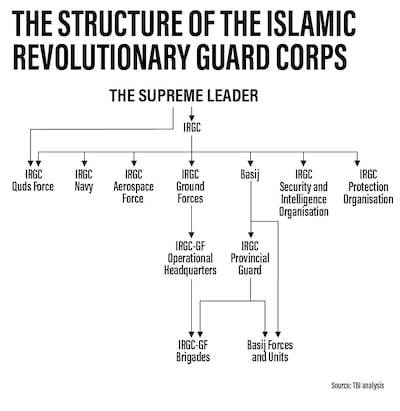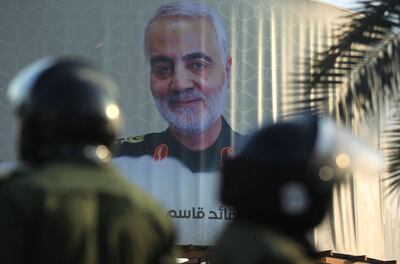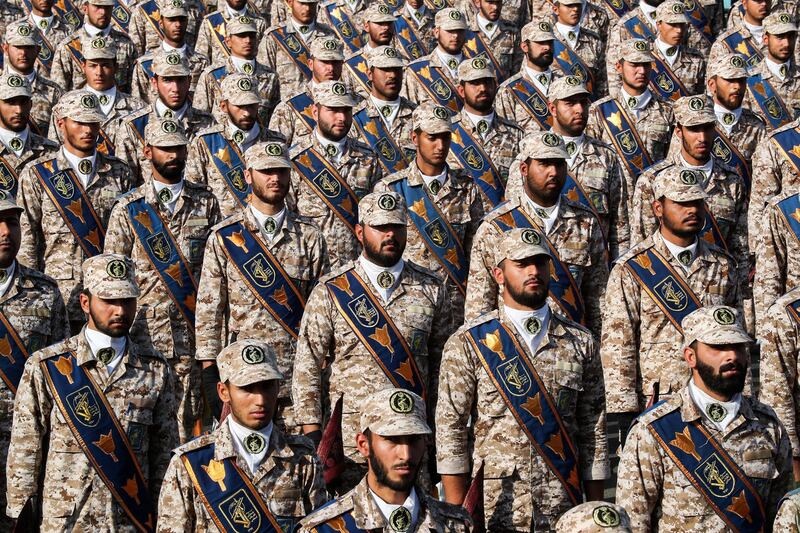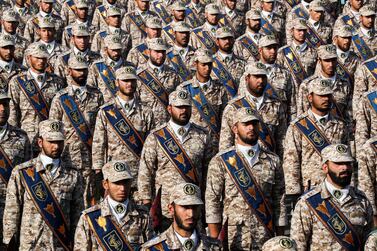Iran seeks to "replicate at speed" its most powerful allied militias throughout the Middle East region and has developed a new template for building alliances, a report from the Tony Blair Institute for Global Change said on Thursday.
At one level, Tehran is fashioning its own version of scholar Joseph Nye's soft-power framework but its work escalates all the way up to directing militias in civil wars and provision of arms.
The report identifies cultural, educational, religious, humanitarian and diplomatic bodies involved in recruiting and indoctrinating foot soldiers.
These use the international privileges afforded to Iran as a nation-state to establish a physical presence in target nations.
"The creation of a presence enables the regime to move operatives to host nations under an apparently legitimate guise," said the report, The View from Tehran: Iran's Militia Doctrine.
"This physical presence allows the process of recruitment to begin, with Tehran targeting individuals and communities susceptible to the regime’s ideology."
The effort is backed up by payments and welfare provisions to reinforce recruitment.
To build loyalties, the Iranian envoys then conduct a process of indoctrination and disseminate ideological propaganda.
Key to this is the network of cultural and religious centres that hand out propaganda material that is pro-regime and anti-American or anti-Israeli.
"A gradual process of radicalisation enables the regime to identify individuals or groups that embrace or show enthusiasm towards the core tenets of Tehran’s worldview," the report adds.
"Over time, the initial process of light indoctrination, which often occurs in the host nation, results in direct opportunities to visit Iran, allowing for more rigorous indoctrination."
Taking the process to the next stage, the Islamic Revolutionary Guard Corps will seek to form a militia that can be used in its interests.
The IRGC, specifically its foreign operations arm the Quds Force, forms these forces from its network of training headquarters and camps.
Under the direction of the Ramazan Headquarters, it cranks out fighters trained in insurgency and guerrilla warfare.
The report said they were being indoctrinated to fight as "warriors without borders" for supreme leader Ayatollah Ali Khamenei’s ideological goal of creating a pan-Shiite state and eradicating Israel.
"Crucially, in addition to facilities in Iran itself, the IRGC has established a network of headquarters and camps across the Middle East in countries like Iraq and Syria," the report adds.
"In doing so, the IRGC has designed an infrastructure that can function even if the clerical regime in Iran collapses.”
The report finds that, like the IRGC, these manufactured groups do not just serve Iranian state deterrence, but will fight for Mr Khamenei regardless of access to financial support.
Countering them will require a hearts-and-minds counter-insurgency campaign.
Imposing sanctions on Tehran, or giving sanctions relief, will not be enough to cease their activities, the report says.

Tony Blair, the former British prime minister who is now chairman of the Institute for Global Change, said the research showed a return to the pre-2018 status quo would be dangerous.
“This report forms an essential part of the backdrop to how western policy makers approach Iran in the coming months," Mr Blair said.
“None of this means that diplomacy directed at curtailing the nuclear programme of Iran is wrong or misguided; on the contrary, it is necessary.
"But it does make the case for any agreement to act as a comprehensive brake on those destabilising activities.”
The institute identifies a turning point in Iran's approach to developing fighting forces outside the country after the demonstrations following the 2009 elections that pushed the regime to the brink.
The key change was to adapt the training and procedures of the domestic Basij militia.
The architect for this overhaul was Qassem Suleimani, who was killed by a US air strike near Baghdad airport more than a year ago.
Using militias that enforce state control over society was focused on Syria, where the Iranians could defend an ally, President Bashar Al Assad, and resist a threat to Syrian Shiite shrines, including Sayyida Zaynab.

"Suleimani called on IRGC commanders who were directly involved in suppressing Iran’s protests to travel to Syria and support this effort," the report said.
"This led to the creation of the so-called Syrian people’s Basij, also known as the National Defence Force.
"Remarkably, the IRGC’s plan for the NDF was not restricted to warfare but had five dimensions: military, security, economic, political and ideological-cultural.
"Ideological indoctrination had proven vital in increasing the willingness of Iranian Basij members to suppress popular uprisings at home against the Iranian regime."
The defence of the shrines became a ideological moment that allowed Tehran to radicalise Iraq's Heydarioun militias – including elements of Asaib Al Haaq, Kataib Hezbollah and the Badr Corps – to fight in Syria.
Looking to the longer term, Mr Khamenei has driven the establishment of a university tier for the militia system.
"Al Mustafa International University is, to all intents and purposes, Iran’s global engine of indoctrination and greatest soft-power asset abroad," the report said.
The university was founded by Mr Khamenei in 2007 from two Iranian religious organisations: the World Centre of Islamic Sciences; and the Organisation of Seminarians.
The institution' teaching is organised around Khameneist thoughts and speeches, and the ideological goals of the 1979 revolution.
"As Ali Abbasi, the head of Al Mustafa, asserts, the university’s 'mission is to organise religious schools in line with [spreading] the Islamic Revolution abroad',” the report said.
"Al Mustafa has more than 170 branches in and outside Iran and operates in over 80 countries, including in Asia, Africa and European cities such as London."
Where the Iranian regime has poured resources into cultivating and organising a phalanx of allies in Syria and Iraq, it is now devoting efforts to Yemen as well.
The capital Sanaa has been controlled since 2014 by the Iran-backed Houthi militias.
"There are hundreds of Yemeni students from Houthi tribes studying in Iran at places like Al Mustafa International University, some of whom have explicitly displayed ideological loyalty to Khamenei," the report said.







